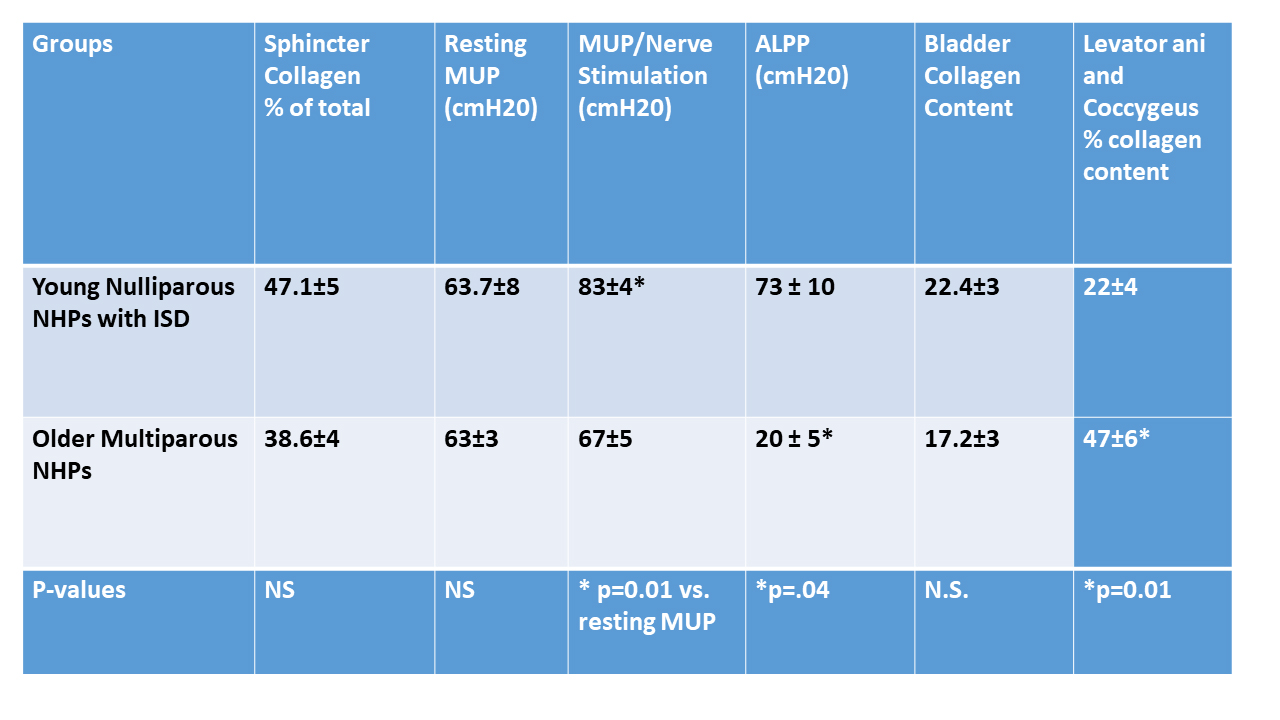Back
Poster, Podium & Video Sessions
Podium
PD34: Urodynamics/Lower Urinary Tract Dysfunction/Female Pelvic Medicine: Female Incontinence: Therapy II
PD34-11: Effects of Age and Multiple Vaginal Births on Urinary Bladder, Sphincter Structure, Function and Pelvic Support in Nonhuman Primates.
Saturday, May 14, 2022
5:10 PM – 5:20 PM
Location: Room 244
J. Koudy Williams, Shannon Lankford, Gopal Badlani*, Winston-Salem, NC
.jpg)
Gopal H. Badlani, MD,FACS,FRCS (he/him/his)
Prof & Vice Chair Urology
Wake Forest University
Podium Presenter(s)
Introduction: INTRODUCTION AND
Objective: Both aging and childbirth are associated with lower urinary tract dysfunction. However, the relative contribution of urinary bladder, urinary sphincter dysfunction and pelvic support remains unclear. This study uses female nonhuman primates (which have a 28 day menstrual cycle, an upright sitting posture and pelvic bladder and urinary sphincter) to address this issue.
Methods:
Methods: Eight older (17-19 years of age, who have had an average of 7 live vaginal births) cynomolgus monkeys were compared to 6 younger (5 years of age, nulliparous) monkeys. Sedated abdominal leak point pressures (ALPP) were performed as well as urodynamic measures of sphincter maximal pressures (MUP) at rest and during pudendal nerve stimulation. Urinary sphincters, bladders and pelvic support muscles (levator ani and coccygeus) were examined for collagen content Masson’s trichrome, and picosirius red staining) and collagen fiber characteristics using CT-FIRE analysis.
Results:
Results: Aging and multiple vaginal births did not affect resting MUP measures, but did reduce the increase in MUP during pudendal nerve stimulation seen in the younger nulliparous monkeys (p < 0.05) (Table 1). Age and multiple births did not affect total sphincter or bladder collagen content (Table 1, p>0.05), but did increase collagen content and reduce muscle content in the pelvic support muscles (p < 0.05) (Table 1). ALPP was significantly lower in the older multiparous group than the young nulliparous group (Table 1, (Table 1, p< 0.05).
Conclusions:
Conclusions: Results in this highly translatable animal model indicate that Lower urinary tract dysfunction associated with age and multiple births may be more a result of reduced sphincter response to neuronal stimulation and reduced pelvic support rather than intrinsic urinary sphincter or bladder structural and functional pathology.
Source of Funding: Source of
Funding: National Institutes of Health, NIDDK

Objective: Both aging and childbirth are associated with lower urinary tract dysfunction. However, the relative contribution of urinary bladder, urinary sphincter dysfunction and pelvic support remains unclear. This study uses female nonhuman primates (which have a 28 day menstrual cycle, an upright sitting posture and pelvic bladder and urinary sphincter) to address this issue.
Methods:
Methods: Eight older (17-19 years of age, who have had an average of 7 live vaginal births) cynomolgus monkeys were compared to 6 younger (5 years of age, nulliparous) monkeys. Sedated abdominal leak point pressures (ALPP) were performed as well as urodynamic measures of sphincter maximal pressures (MUP) at rest and during pudendal nerve stimulation. Urinary sphincters, bladders and pelvic support muscles (levator ani and coccygeus) were examined for collagen content Masson’s trichrome, and picosirius red staining) and collagen fiber characteristics using CT-FIRE analysis.
Results:
Results: Aging and multiple vaginal births did not affect resting MUP measures, but did reduce the increase in MUP during pudendal nerve stimulation seen in the younger nulliparous monkeys (p < 0.05) (Table 1). Age and multiple births did not affect total sphincter or bladder collagen content (Table 1, p>0.05), but did increase collagen content and reduce muscle content in the pelvic support muscles (p < 0.05) (Table 1). ALPP was significantly lower in the older multiparous group than the young nulliparous group (Table 1, (Table 1, p< 0.05).
Conclusions:
Conclusions: Results in this highly translatable animal model indicate that Lower urinary tract dysfunction associated with age and multiple births may be more a result of reduced sphincter response to neuronal stimulation and reduced pelvic support rather than intrinsic urinary sphincter or bladder structural and functional pathology.
Source of Funding: Source of
Funding: National Institutes of Health, NIDDK


.jpg)
.jpg)